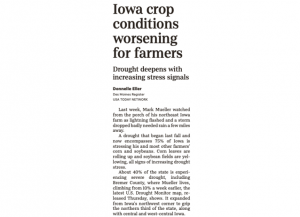Bloomberg's Leah Nylen reported Thursday that "a Colorado judge issued an order temporarily blocking the proposed $25 billion merger of Kroger Co. and Albertsons Cos., which has been challenged by…
Drought Expands in Iowa, Stressing Crops- as Soybean and Corn Prices Tumble
Donnelle Eller reported on the front page of Friday’s Des Moines Register that, “Last week, Mark Mueller watched from the porch of his northeast Iowa farm as lightning flashed and a storm dropped badly needed rain a few miles away.
“A drought that began last fall and now encompasses 75% of Iowa is stressing his and most other farmers’ corn and soybeans. Corn leaves are rolling up and soybean fields are yellowing, all signs of increasing drought stress.

“About 40% of the state is experiencing severe drought, including Bremer County, where Mueller lives, climbing from 10% a week earlier, the latest U.S. Drought Monitor map, released Thursday, shows. It expanded from Iowa’s northwest corner to grip the northern third of the state, along with central and west-central Iowa.”
#Drought Monitor- #Iowa. pic.twitter.com/NdMbgUXzBc
— Farm Policy (@FarmPolicy) June 17, 2021
Ms. Eller explained that, “June is usually one of Iowa’s wettest months, historically averaging 5.02 inches of rain — moisture that’s essential for crops in their early stages of growth. By Thursday morning, Iowa had averaged 2.4 inches for the month, according to Justin Glisan, the state climatologist.
“So far, much of Iowa in June has experienced some of the driest weather seen in 129 years of record keeping, unofficial data from an Iowa State University environmental monitoring site show.”
Approximately 41% of #corn production is within an area experiencing #drought, @usda_oce pic.twitter.com/qbHBzRSzex
— Farm Policy (@FarmPolicy) June 17, 2021
The Register article noted that, “Even though Thursday’s temperatures hit 100 degrees across much of Iowa, the weather outlook the next seven to 14 days ‘leans cooler and wetter for the state,’ [Dennis Todey, director of the U.S. Department of Agriculture’s Midwest Climate Hub in Ames] said. Parts of Iowa could get a half inch to an inch or more.
“‘We really need rainfall to come in this next system … otherwise, we could have much worse conditions on our hands,’ he said.
“But Iowa farmers will need an average of about an inch of rain every week for the rest of the growing season to keep pace with corn and soybeans’ moisture needs.”
New Seasonal Drought Outlook from @NOAA’s @NWSCPC
— NIDIS Drought.gov (@DroughtGov) June 17, 2021
The Good: Drought removal is likely for the East Coast + PR
And S. AZ + S. NM into TX may see some improvement
The Bad: #Drought will likely worsen for parts of the Plains into the Pacific Northwesthttps://t.co/4kMDMVIfFf pic.twitter.com/C3mJbL2Y31
And Reuters writer Karl Plume reported this week that, “A harsh drought grew more severe across major parts of the U.S. farm belt this week, threatening recently planted corn, soybean and spring wheat crops in Iowa, Minnesota and the Dakotas, meteorologists and climatologists said on Thursday.
“Rains forecast for the northern Midwest and Great Plains this weekend and next week will bring relief to some areas. But the severe moisture deficits suggest crop yields in key U.S. production areas remain at risk.”
#Drought Monitor- North Central States. pic.twitter.com/lcscpnVoCD
— Farm Policy (@FarmPolicy) June 17, 2021
The Reuters article noted that, “Cooler weather this weekend and some rain through next week will bring some relief to crops in the western Corn Belt, although far northern areas may see less rain.”
Mr. Plume also pointed out that, “October to April was the driest stretch in North Dakota history since record keeping began 127 years ago, Gov. Doug Burgum told a town hall meeting in Washburn, North Dakota, on Wednesday.”
Meanwhile, Reuters writer Julie Ingwersen reported this week that, “U.S. corn and soybean futures fell sharply on Thursday, pressured by outlooks for rain and cooler temperatures in the Midwest crop belt, as well as spillover weakness from broad-based selling in the commodities sector, analysts said.
“Wheat followed the weaker trend, with the U.S. winter wheat harvest under way.”
Incredible moves. Will we ever really figure out what was behind them? https://t.co/rzFnFarMuU
— Scott Irwin (@ScottIrwinUI) June 17, 2021
And Dow Jones News writer writer Kirk Maltais reported this week that, “Weather models have added additional rainfall to their forecasts, putting pressure on grain futures throughout Thursday.”
AGRICULTURAL MARKET: Corn and soybean plunging today, down nearly 7% on the day. Most active soybeans contract has moved out of the "teens" for the first time in more than two months | #OATT
— Javier Blas (@JavierBlas) June 17, 2021
Also this week, Bloomberg writers Yvonne Yue Li and Marvin G Perez reported that, “For all the talk of a commodities boom, some markets have now wiped out gains for the year and several more are close to doing so.
Soybean futures have erased their 2021 advance, sliding more than 20% from an eight-year high reached in May, while corn and wheat have also tumbled.
“The Bloomberg Grains Spot Subindex slid the most since 2009 on Thursday, before edging higher on Friday as markets recovered some losses. Other commodities that have seen their big rallies evaporate include platinum, while once-surging nickel, sugar and even lumber have faltered.”

The Bloomberg article added that, “Soybean futures in Chicago bounced more than 2% on Friday, but are still heading for a weekly loss of about 11%, the worst performance in seven years. Corn and wheat also recovered a part of Thursday’s declines.”





